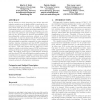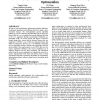107
Voted
GECCO
2008
Springer
15 years 2 months ago
2008
Springer
Genetic algorithms (GAs) used in complex optimization domains usually need to perform a large number of fitness function evaluations in order to get near-optimal solutions. In rea...
GECCO
2008
Springer
15 years 2 months ago
2008
Springer
This paper demonstrates the effectiveness of genetic algorithms in training stable behavior in a model of the spinoneuromuscular system (SNMS). In particular, we test the stabili...
GECCO
2008
Springer
15 years 2 months ago
2008
Springer
In this work a branch prediction system which utilizes evolutionary techniques is introduced. It allows the predictor to adapt to the executed code and thus to improve its perform...
GECCO
2008
Springer
15 years 2 months ago
2008
Springer
In this paper we demonstrate how genetic algorithms can be used to reverse engineer an evaluation function’s parameters for computer chess. Our results show that using an approp...
93
Voted
GECCO
2008
Springer
15 years 2 months ago
2008
Springer
Recent advances in XCS technology have shown that selfadaptive mutation can be highly useful to speed-up the evolutionary progress in XCS. Moreover, recent publications have shown...
GECCO
2008
Springer
15 years 2 months ago
2008
Springer
Hereditary Repulsion (HR) is a selection method coupled with a fitness constraint that substantially improves the performance and consistency of evolutionary algorithms. This als...
101
Voted
GECCO
2008
Springer
15 years 2 months ago
2008
Springer
We study the minimum s-t-cut problem in graphs with costs on the edges in the context of evolutionary algorithms. Minimum cut problems belong to the class of basic network optimiz...
102
Voted
GECCO
2008
Springer
15 years 2 months ago
2008
Springer
The realization of a control unit can be done using a complex circuitry or microprogramming. The latter may be considered as an alternative method of implementation of machine ins...
97
Voted
GECCO
2008
Springer
15 years 2 months ago
2008
Springer
In order to solve nonstationary optimization problems efficiently, evolutionary algorithms need sufficient diversity to adapt to environmental changes. The dual-population genetic...
103
Voted
GECCO
2008
Springer
15 years 2 months ago
2008
Springer
Recently, a number of works have been done on how to use Genetic Algorithms to solve the Portfolio Optimization problem, which is an instance of the Resource Allocation problem cl...






